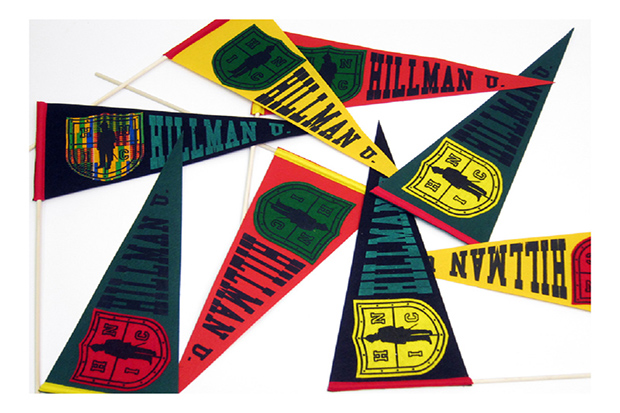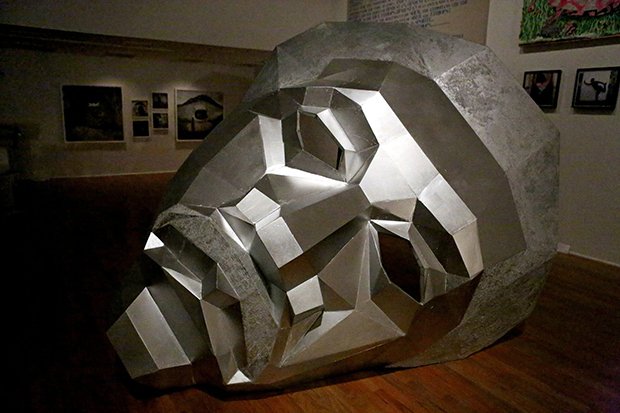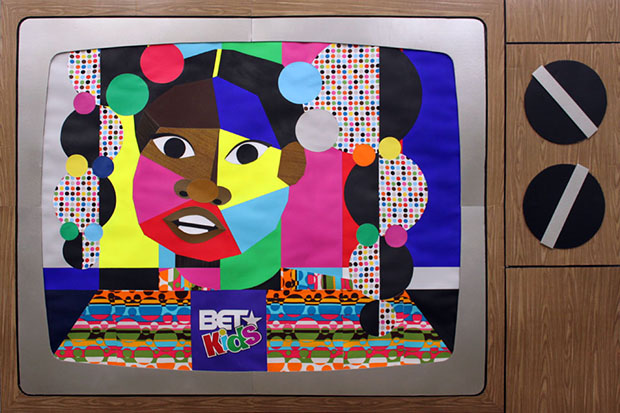Reimagining Blackness
Derrick Adams' art has been on TV shows and in major museums. Professor Isaiah Wooden says Adams transforms our view of African American identity.
In the second season of HBO's “Insecure,” a comedy about the lives of black twenty-something women, the characters visit a museum and admire a large multi-colored collage showing a vintage television with the floating head of an African American girl on the screen.
On the smash-hit show “Empire,” the ex-record label executive Cookie Lyon refuses to sell one piece of art from her collection after she goes broke — a portrait of her and her husband made up of mostly brown, black and gold geometric shapes.
Isaiah Wooden
In real life, both works are by the Brooklyn-based visual and performance artist Derrick Adams.
In painting, prints, sculpture, drawing, video and live performances, Adams explores the intersection of race, black identity and popular culture. His installations take apart and reclaim images of African Americans throughout history to redefine blackness and race for our times.
In a recent article in The Black Scholar, Isaiah Wooden, assistant professor of theater arts, wrote about Adams' oeuvre and the ways he "activates multigenerational conversations that attest to the thickness of Black life and experience."Below are Wooden’s thoughts on three of Adams' works that he discusses in his research paper:
Hillman U: A Dream Deferred; A Dream Fulfilled (2012)

Adams created these banners, Wooden says, to conjure memories of the 1980s and early 90s TV programs "The Cosby Show" and its spinoff, "A Different World."
Both shows featured a fictional historically black college called Hillman.The Cosby Show was a major transitional moment in popular culture, offering a unique depiction of the lives of successful African American professionals.
Through these pennants Adams invites us to consider the legacy of the show's representations of blackness and the educational aspirations of black people, says Wooden.
At the same time, Adams seeks to place Hillman within a longer history of black liberation struggles. Wooden points out that the red, black and green in the pennants use the same colors as the flag of the Universal Negro Improvement Association, started by Marcus Garvey in 1914 as part of the Pan-Africanist movement.
We><Here (2013)

In 1978, Universal Pictures released "The Wiz," a reimagining of the "Wizard of Oz" set in New York City with a black cast that included Diana Ross and Michael Jackson. In this sculpture, Adams riffs on the huge, fire-breathing statue that greets Dorothy and her companions in Oz.
Wooden sees the piece, which is almost 8-feet long, as a commentary on power. The Wiz, of course, turns out to be a mere mortal. In laying the head on its side as if the statue had been toppled, Adams reminds us that power is often more symbolic than real.Adams asks "what it means to overinvest in a charismatic leader," Wooden says, making the sculpture highly relevant to our times.
Pilot #1 (2014)

When the characters in “Insecure” see this collage, it sparks a conversation about the pleasures and perils of dating as a black woman in the 21st century.
The visage on the TV screen notably resembles Rudy Huxtable, the elementary-school-aged daughter in the "Cosby Show," whom Wooden describes as "one of the most iconic television representations of black girlhood."
The four central characters in “Insecure” are the kind of professional black women Rudy might have grown up to be. The colorful background gives the work a "bubble-gum quality that suggests fun and innocence," Wooden says.
At the same time, the BET Kids logo is a reminder of corporate control over representations of black childhood. Originally a black-owned business, BET now belongs to the entertainment conglomerate Viacom.
Wooden says “Pilot #1" reminds us of the commercialization of blackness while simultaneously creating something new and beautiful, a true work of art that allows for a new exploration of black identity.
Categories: Humanities and Social Sciences, Research





